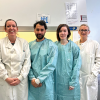A US multi-centre study revealed that a liquid biopsy is comparable to standard tissue biopsies in detection of guideline recommended biomarkers in advanced non-small cell lung cancer (NSCLC).
It also has a faster turnaround time, and has the potential to support identification of more patients who can be treated with targeted therapy.
The authors say the study findings are significant, given that 30% of lung cancers can be treated successfully with molecular-targeted therapies, which often yield higher response rates than chemotherapy.
Study lead Vassiliki Papadimitrakopoulou said: “When choosing therapy for patients with NSCLC, it is vital that we know which patients have gene mutations that often respond to molecular therapies.
“In the past, our only option to test for mutations was to rely on tissue-biopsy-based testing, which can be invasive, have serious complications, is time-consuming and often not adequate to test for all relevant targetable mutations.”
In this study, the liquid biopsy employed cell-free tumor DNA (cfDNA) in blood to test for mutations in 282 patients. It detected seven known predictive biomarkers.
Standard tissue sampling detected at least one of predictive biomarkers in 60 patients, while the liquid biopsy identified biomarkers in 77 patients.
Among the remaining 193 patients who did not have one of the seven biomarkers, the liquid biopsy test found the KRAS mutation in 92 patients, compared to 24 patients with standard tissue sampling.




